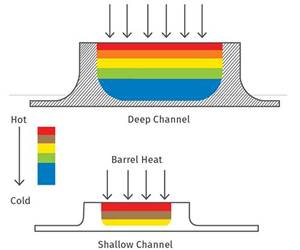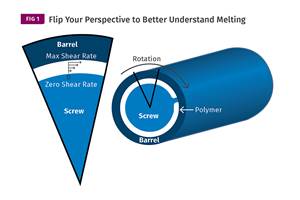How To Identify Resin Degradation in Single-Screw Extruders
Degradation can occur in many single-screw extrusion operations, and typically occurs due to minor design flaws in the screw. Here is how to track it down.
Resin degradation products often cause defects in finished goods such as polyethylene (PE) film, sheet and injection molded parts. Most often the degradation is caused by segments of the process that are stagnant to flow, allowing the resin to be at high processing temperatures for extended periods of time. Once formed, small process instabilities will cause the degradation products to separate from the screw and contaminate the product. This degradation process can occur in many single-screw extrusion operations, and it typically occurs due to minor design flaws in the screw.
The location in the screw where the resin is degrading can be difficult to identify from a screw schematic or by operational experiments. Instead, the best way to determine the location is to remove the screw hot from the extruder and examine it for resin degradation.
The screw removal procedure is very simple and only complicated by the downstream equipment because the transfer line must be disconnected from the extruder. First, the extruder should be operated with the same feedstock resin with the additives and colorants removed. Additives and especially colorants in the extruder will make observing the degradation more difficult. The extruder should be operated until all additives are clearly not in the extrudate.
Next, the hopper is allowed to run empty while the screw is still rotating. The goal here is to discharge as much resin as possible from the channels, making observations and cleanup easier. Once resin is no longer discharging from the die, screw rotation can be stopped. The barrel heaters should remain at the normal temperatures or decreased slightly. Lower barrel temperatures will decrease the rate of degradation during the screw removal process. The temperatures must maintain the resin in the molten state.
FIG 1 A 2.5-inch diameter screw being pushed out of an extruder hot. Source (all images): M. Spalding
The transfer line is now disconnected from the extruder. The screw is pushed out of the barrel using either a hydraulic jack or a simple screw jack. The screw should be pushed out about 4 diameters. A photograph of this is shown for a 2.5-inch diameter extruder by Figure 1 for a PE resin. These four diameters of screw are now studied and photographed for degradation. A level of degradation is clearly observed at the flight corners in Figure 1 and expanded in Figure 2. The root cause of this degradation is from the formation of Moffatt eddies.
FIG 2 Close-up photograph of the resin degradation at the flight radii in the metering section.
Moffatt eddies were discussed in this magazine in September 2018. They are recirculating flows that cause the resin to have extremely long residence times, leading to resin degradation. They occur because the flight radii are too small.

FIG 3 Schematics for the flight radii in the metering section of the screw: (a) a small radius will likely cause Moffatt eddies to form leading to resin degradation, and (b) a large flight radius that will not cause resin degradation.
Increasing the flight radii to about 1.4 to 1.5 times the local channel depth will eliminate Moffatt eddies and mitigate resin degradation for most resins. A schematic for small and large flight radii are provided in Figure 3. Screw fabricators typically set the flight radii to 0.5 times the local channel depth because they are easier to fabricate and they are the industry standard. Flight radii at 0.5 times the depth, however, can cause Moffatt eddies and degradation for many resins. Most fabricators will accommodate requests for larger flight radii.
After the first four diameters are studied and photographed, this portion of the screw can be cleaned to bare metal while it is hot. Only brass tools should be used for cleaning because brass will not damage the screw surface. Never use steel tools or burn the resin off with a torch. Steel tools can damage the screw surface, and the high temperatures of a torch can change the morphology of the metal, or damage surface plating or the hard facing on the flight lands.

FIG 4 Maddock mixer with resin degradation in the flutes.
Next, the screw is pushed out another 4 diameters. Like before, this newly exposed segment is studied for resin degradation and photographed. For the same 2.5-inch diameter screw, the next segment is shown by Figure 4. This segment was designed with a Maddock mixer. There is a considerable level of resin degradation on the flute edges. This degradation was caused by the flutes being too deep relative to their width. This problem was discussed in a March 2024 article.
In general, the width of the flutes should be twice the depth. A common design error is to construct the Maddock mixer with too many flute pairs, creating flutes with small widths. Next, the designer cuts the flutes too deep so that pressure consumption is not a large problem. This type of design works well from a temperature and pressure viewpoint, but it can cause resin degradation at the flute edges. As before, the segment is cleaned.
FIG 5 Metering section of a screw with a poorly designed barrier flighted entry. The white material is freshly melted LDPE while the dark material is degraded and crosslinked resin.
Pushing the screw out another 4 diameters should expose the entry to the metering section and the exit of the melting section. If a barrier melting section is used and if the entry to the section is not designed properly, it is possible the specific rate could be reduced by nearly 50% and cause the metering channel to operate starved. Specific rate is simply the rate divided by the screw speed, and it has units of lbs/(hr rpm). Starved metering channels can cause resin degradation as shown by Figure 5.
This problem was discussed previously in this magazine (November 2024). This specific rate reduction and resin degradation problem was caused by a restriction between the solids conveying channel and the solids channel of the barrier section. This restriction can severely limit specific rate.
FIG 6 Schematic of a spiral dam mixer: (a) side view showing locations that can be stagnant and cause resin to degrade, (b) unwrapped view, and (c) a cross-sectional view perpendicular to the flight edge showing the clearance between the dam and the barrel wall.
Some mixer styles are notorious for creating stagnation and resin degradation. These types of mixers include some spiral dam and gear mixers. For example, a schematic of a spiral dam mixer is shown by Figure 6. The mixer is positioned in the metering channel, and it is typically about 3 diameters in length. It has a dispersive mixing flight that starts at the pushing side of the channel and advances to the trailing side of the channel, as shown by Figure 6.
The mixing flight is undercut to enable resin to flow from in the inlet channel to the outlet channel. Stagnant regions can occur at the start of the outlet flow channel and at the end of the inlet flow channel, as shown in Figure 6a. Not all spiral dam mixers will have stagnant regions as many designers will undercut the entrance and exit regions, and taper the channels up to the top of the undercut.
FIG 7 Screw above has had numerous shutdowns where the extruder was maintained at operating temperatures for extended time. The extruder was purged prior to removing the screw, yet dark degraded resin covers most areas of the metering section.
If an unplanned shutdown occurs, the barrel temperatures should be decreased if the shutdown is going to be longer than 30 minutes. For many operations, the downtime tends to be longer than estimated. If the barrel temperatures are maintained at processing conditions, resin degradation can form on the entire metering channel. An example of this type of degradation is shown in Figure 7. Here, resin degradation is typically observed across the entire screw root and flight radii. This type of degradation can make startups difficult due to the long purge times required to flush the degradation from the extruder.
Although the examples here are for PE resins, similar resin degradation has been observed for other resins, including polystyrene, polycarbonate, polypropylene and ABS, to name a few.
The problems described above can occur with plasticating screws designed for injection molding machines. The procedures and remedies are identical to those described here for extruders, except that the injection ram is used to push the screw out of the barrel.
About the Author: Mark A. Spalding is a fellow in Packaging & Specialty Plastics and Hydrocarbons R&D at Dow Inc. in Midland, Michigan. During his 39 years at Dow, he has focused on development, design and troubleshooting of polymer processes, especially in single-screw extrusion. He co-authored with Gregory Campbell. Contact: 989-636-9849; maspalding@dow.com; .
Related Content
The Importance of Barrel Heat and Melt Temperature
Barrel temperature may impact melting in the case of very small extruders running very slowly. Otherwise, melting is mainly the result of shear heating of the polymer.
Read MoreMaximize the Cooling Capacity of Your Extrusion Line
Maximizing output in extrusion requires a thorough understanding of not only the cooling requirements of the extruder but of the extrudate as well.
Read MoreUnderstanding Melting in Single-Screw Extruders
You can better visualize the melting process by “flipping” the observation point so the barrel appears to be turning clockwise around a stationary screw.
Read MoreUnderstanding the Incumbent Resin Effect
When you are looking to replace an existing resin with a new one, in trials sometimes the “incumbent” resin will cause gels and other defects. Here’s what to look for.
Read MoreRead Next
For PLASTICS' CEO Seaholm, NPE to Shine Light on Sustainability Successes
With advocacy, communication and sustainability as three main pillars, Seaholm leads a trade association to NPE that ‘is more active today than we have ever been.’
Read MoreBeyond Prototypes: 8 Ways the Plastics Industry Is Using 3D Printing
Plastics processors are finding applications for 3D printing around the plant and across the supply chain. Here are 8 examples to look for at NPE2024.
Read More









